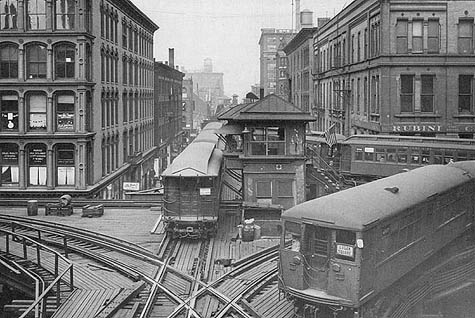
For decades, the Tower 18
junction at Lake & Wells was billed as the busiest
railroad junction in the world. The towerman certainly had a
lot on his hands in this photo looking north from the
transfer bridge at the adjacent Randolph/Wells
station: A 4000-series
Baldie turns south (right front) on its way back to
Logan
Square via the Met
main line and a southbound Englewood Express of wooden cars
flies through (left), while a crosstown train of South Side
cars, one of which is designated as a Smoker (below the
American flag on the tower) turns north onto Wells. For a
larger view, click here.
(Photo from the Chicago Transit
Authority Collection)
|
Tower
18
Wells Street and Lake
Street, Loop
Service
Notes:
|
Services:
|

|
Green Line:
Lake-Ashland-East 63rd
|

|
Brown Line:
Ravenswood
|

|
Orange Line:
Midway
|

|
Purple Line:
Evanston Express
|

|
Pink Line:
54/Cermak-Loop
|
Quick Facts:
Established: October 3,
1897
Original Line: Union Elevated Railroad
Rebuilt: 1969
Status: In Use
Profile:
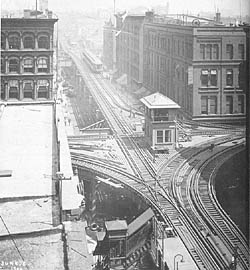
This view looks north on
Fifth Avenue (Wells Street) at Tower 18 from Randolph. The
Randolph
& Wells station
can be seen in the bottom of the photo. Note also the cables
leading from the signal in the lower right, between the
tracks, to the tower, where hand-throw levers controlled the
semaphore readings. For a larger view, click
here.
(Photo from the Bruce G. Moffat
Collection)
|
The location that is now home to Junction 18 (and Tower 18) began
life not as a junction but as a station. On September 22, 1895, a new
section of structure was opened over Lake Street from Market to Wabash, with
through trains of the Lake Street Elevated rerouted from the
Market & Madison
terminal to the new downtown terminal at State
& Lake. Additional stations were provided at Clark
and at Fifth [Wells] on the extension, which was planned to
become the north leg of an as-yet-unbuilt Union Loop. In 1896,
construction began on the rest of the Loop and Lake Street trains
were the first to be routed on the new quadrangle when it opened on
October 3, 1897. As a result of the construction, the south platform
and station house of the Lake Street's Fifth Avenue station were
removed to connect the west leg of the Loop (which used Fifth Avenue)
to the north leg. (To compensate for the loss of the station, Randolph/Wells was
actually built midway between Randolph and Lake Streets, with the
station house over Couch Place, a glorified alley. An entrance to
Randolph/Wells was
not built at Randolph Street until 1913.) Although the north (eastbound)
station house and platform at Fifth Avenue remained for the time
being, Junction 18 was now established at the corner of Fifth &
Lake where the Lake Street Elevated connected at the northwest corner
of the Loop. There was still no Tower 18, however, as there were
actually no crossovers or switches in the initial configuration.
In early 1900, the Northwestern Elevated Railroad neared
completion and was to connect to the Loop at Lake & Fifth, at the
same corner as the Lake Street Elevated. This required the December 17, 1899
closure and eventual removal of the eastbound platform and station
house of the Fifth Avenue station (making it one of the shortest
lived stations in "L" history). Tower 18 was now established.
So, why is Tower 18 called "Tower 18"? For administrative reasons
that have now become unclear, the 11 stations and and three junctions
on the Loop were assigned numbers beginning at the Van Buren &
Fifth junction and counting up going counterclockwise around the
Loop. The scheme progressed as follows:
|
8 - Fifth & Van Buren junction
|
|
9 - Pacific (LaSalle) & Van Buren station
|
|
10 - Dearborn & Van Buren station
|
|
11 - State & Van Buren station
|
|
12 - Van Buren & Wabash junction
|
|
13 - Adams & Wabash station
|
|
14 - Madison & Wabash station
|
|
15 - Randolph & Wabash station
|
|
16 - State & Lake station
|
|
17 - Clark & Lake station
|
|
18 - Lake & Fifth station (junction, after 1899)
|
|
19 - Randolph & Fifth station
|
|
20 - Madison & Fifth station
|
|
21 - Quincy & Fifth station
|
No records have survived that indicate what numbers 1-7 were to be
used for, although they may have been assigned to the Union
Consolidated line west of Market Street, for which the company
received a franchise but had no real intention of constructing.
Another theory is that they were for the various stub terminal
stations and junctions, and for the Met's Franklin
& Van Buren station.1 In any case, these administrative
numbers survive today only in the names of the two remaining original
junction towers: 12 and 18.
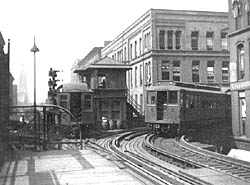
A northbound Northwestern
Elevated train (left) passes through Tower 18 on its way
north after leaving Randolph
& Wells, just as
a westbound Metropolitan train turn off Lake Street and into
Randolph
station. For a larger view, click here.
(Photo from the Fred Borchert/Robert Gibson
Collection)
|
The tower itself was a two-story affair set inside the junction
between the various intersecting and diverging tracks. Its
architecture was more practical than of any particular style, but did
feature decorative window frames and sills, belt course moldings, and
a hipped roof with a small chimney for the coal-burning stove inside.
Entrance to the first floor was through a door at track level. Access
to the second floor was also from outside, via a stairway on the
exterior of the tower. The interior space was tight. With windows on
all sides for maximum visibility, the tower was heated only by a
small iron potbelly stove in the corner of the room. The junction was
equipped with a hand-operated lever form of switch and signal
control. This made the interior a dizzying array of levers and
switches, all of which had to be precisely aligned by a vigilant
towerman. In 1907, this system was retired in favor of an
electro-pneumatic interlocking system that survived until the original tower's
demolition. The electro-pneumatic system increased the junction's
safety, for it meant that an incorrectly set switch could not result
in a collision. However, the towerman was still required to make
hundreds of precise routing and sequencing decisions or risk delaying
the entire railroad.
Before the Loop opened, a preliminary operating plan was developed
in 1895. According to The Economist, trains would circle the
Loop bidirectionally using the right-hand track. Lake Street and
Northwestern trains would operate in a clockwise circle using the
Inner Loop, while South Side and Met trains would circle in the
opposite direction on the Outer Loop. A major drawback of this plan,
however, was the excessive number of conflicting movements that would
occur at Tower 18. Thus, an alternate operating plan was developed,
with trains operating left-handed. The pairings would remain the
same, but the track assignments were swapped.
From 1900 to 1913, the track configuration of the junction
remained largely the same. The Loop's left-hand running was very
unusual in America, but was shared by two other "L" routes. The
Northwestern Elevated was left-handed from its opening in 1900. The
Lake Street was initially only left-handed for one block, between the
Loop and a crossover at Franklin, at which point it resumed the
right-hand running of the rest of the line. This practice remained in
effect until August 7, 1902 when the railroad switched from right- to
left-hand operations between Franklin and Austin to reduce switching
delays and complicated Loop track assignments in preparation for the
inauguration of the line's express service. The Metropolitan and
South Side elevateds started as and remained right-hand railroads,
making the changeover to left-hand operation upon their entrance to
the Loop at Towers 8 and 12,
respectively. In the initial configuration of Junction 18, the Inner
Loop track, which carried the South Side and Met trains, simply
curved from Lake to Wells with no switches to the other tracks. The
Outer Loop track, however, held a multitude of different routing
possibilities. Northwestern trains entered the Loop, turning left
from Fifth onto the Outer Loop over Lake, and left the Loop
northbound continuing straight ahead on the outer track over Fifth.
Lake Street trains followed a similar pattern, entering by continuing
straight east onto the outer track over Lake and returning to their
home rails by turning west from the Outer Loop over Fifth onto the
left-hand track over Lake Street. There as also an
"Outer-Loop-around" track, but this was not used in any regular
revenue operations.
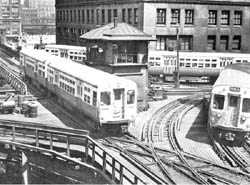
No Lines, No
Waiting: Three trains of 6000-series
cars simultaneously pass through Tower 18 in the early-1950s
in the only sequence possible without waiting for a train to
clear. The two-car train on the left is a Ravenswood heading
south into Randolph/Wells
while the two-car train behind the tower is another
Ravenswood turning off the Outer Loop on it way back to
Kimball.
The train on the right is a Douglas train, turning south
into Randolph/Wells
on its way back to Cicero-Berwyn
Terminal. In 1954,
Douglas trains would cease turning south here, instead
continuing straight west through Tower 18 to access their
home rails via the Lake Street Line. For a larger view,
click here.
(Photo from the CTA Collection)
|
In 1913, the Chicago Elevated Railways instituted crosstown service.
With many North-South trains now through-routed, the configuration of
Tower 18 would need to be changed. As part of the track realignment,
the tower's electro-pneumatic interlocking system was extensively
re-rigged. All Lake Street and Metropolitan trains still terminated
around the Loop, as well as some night and off-peak Northwestern and
South Side trains. Most North-South trains, however, went through and
this required an extensive reworking of not only the Tower 18
interlocking but also Loop operating procedures. Just after midnight
on November 3, 1913, all trains began operating in a
counterclockwise, unidirectional manner, with Northwestern and South
Side trains on the outer track and Metropolitan and Oak Park (Lake
Street) trains on the inner track. North-South trains operated
northbound via Wabash Avenue and Lake Street, while southbound they
operated via Fifth Avenue (now Wells Street) and Van Buren Street. At
the same time, the Northwestern and Chicago & Oak Park lines
changed from left- to right-hand running to reduce switching delays
at Tower 18. The track configuration at the junction was now
considerably more complicated. Met trains simply followed the inner
track curve from Lake to Wells. Lake Street trains entering the Loop followed a new track that led them from the eastbound Lake Street
track, across the Outer Loop track, and onto the southbound Inner
Loop over Wells; they left the Loop from another new track that led
them from the inner track over Lake, across the "Outer-Loop-around"
and straight southbound Wells track to the westbound Lake Street
track. Northbound North-South trains simply took a curve off the
outer track, making a right turn to the northbound Northwestern track
over Wells; southbound North-South trains simply continued on a
straight course over Wells from the Northwestern onto the Outer Loop.
There also remained the "Outer-Loop-around" track as mentioned above,
now used for South Side trains that terminated in the Loop during
off-peak hours.
By the 1920s, Tower 18 was cited as being the busiest railroad junction in the world. A 1927 map issued by the Chicago Rapid Transit Company, citing its "busiest railroad crossing in the world" credentials, said "in the hour of maximum travel 224 trains of 1,244 cars pass through this corner, or 20 cars every minute. The cars passing this crossing in this hour would make a train 10 miles in length." The CRT continued to promote the junction's "world's busiest" status in 1936, when they claimed a train passed through every 15 seconds during the morning rush hour. Extrapolating the traffic levels into a daily measure, they continued, "in a representative day of 24 hours, normal traffic, a total of 2,098 trains, made up of some 6,400 cars, pass this junction. Coupled together in one continuous string, these cars would make a train 59 miles long."2 Tower 18 would be claimed as the busiest railroad junction in the world for some decades after; it is unclear when it lost this claim, or whether this is still the case.
The 1913 configuration of Tower 18 remained for the next 56
years, despite another crosstown route revamp in 1931 and the opening
of the State Street Subway in 1943. Only small routing changes
occurred. In 1943, Jackson Park-Evanston, Jackson Park-Howard, and
Englewood/Normal Park-Ravenswood trains were rerouted into the
subway, leaving the Kenwood-Wilson and Wilson-Loop rush hour trains
as the only North-South trains running through Tower 18. In 1949, the
CTA's North-South service
revision brought some of these services back, with all Ravenswood and
rush hour Evanston Expresses terminating on the Loop again. In the
1950s, Metropolitan Division trains were slowly siphoned off as well. Logan Square trains were
taken off the Inner Loop in 1951 with the opening of the
Milwaukee-Dearborn Subway. In 1954, Douglas trains were rerouted via
the Lake Street elevated, and thus began following their routing
through Tower 18. In 1958, Douglas and Garfield trains were removed
from the Loop entirely and placed in a subway as part of the
West-Northwest Route. Now only Ravenswood, Evanston Express, and Lake trains remained, the latter of whose routing on the Loop had never
changed since 1913. The only additional change of significance took
place on September 6, 1961, when the "Outer-Loop-around" track was
removed from service.
Up until the 1950s, Wells Street Bridge was controlled from North Water Tower, across the river. North Water Tower was closed on August 10, 1956, with the operating controls for the Wells Street Bridge then transferred to Tower 18. From this point until 1969, there were two interlocking machines and panels in the tower to control the switches at the junction -- both were United Switch & Signal (US&S) Model 14 units -- as well as another panel suspended from the ceiling that controlled the the Wells Street Bridge and Lake Street Bridge.3 One of the two Model 14 EP machines in Tower 18 controlled the junction -- that machine had 11 levers. The other machine had seven levers and controlled two crossovers: one just south of Randolph/Wells, and one just east of the junction on Lake Street at LaSalle. This second machine was used to switch Ravenswood trains to and from the Inner Loop track during off-periods when all trains were routed via the Inner Loop to save the cost of several agents on the Outer Loop. As such, it may have been installed early in the CTA period (this routing was instituted on January 15, 1950).4
Tower 18 Replaced and Relocated
In 1969, the old Tower 18 became a casualty of progress. Its
location in the middle of the intersection was ideal for watching
over the action of the junction. But it also put it in the path of
the new eastbound Lake-Dan Ryan track that was necessary for the new
through-route. A new tower was needed clear of the right-of-way and
so the old two-story frame structure was phased out of service on
September 6, 1969 and dismantled soon thereafter. The next day, the
new, modern Tower 18 was placed in service. At the same time, the
controls for the Washington/Wells crossover two blocks south were
moved from Tower 18 to the temporary Tower 19 (at Washington).
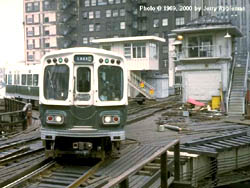
The Changing of the
Guard: A two-car Lake "B" train of 2000-series Pullman cars passes the old and new Tower 18 at Lake &
Wells in June 1969. The new tower was built to accommodate a
reconfiguration of the junction necessitated by the new Dan
Ryan Line. By the end of the year, Lake trains would be
through-routed to the new Dan Ryan Line. For a larger view,
click here. (Photo by Jerry Appleman) |
On September 28th, the new Lake-Dan Ryan routing took effect. The Loop's operating plan was significantly altered again. The Loop
returned to a bidirectional railroad, but used right-hand operation
this time. The track configuration at Tower 18 was again altered for
the new routings. Now, the north-south Ravenswood tracks above Wells
both continued straight through the junction to become the inner and
outer Loop tracks on the Wells leg. Likewise, the east-west Lake
Street Line tracks continued straight through the interlocking,
becoming the inner and outer Loop tracks over Lake Street; the new
Lake-Dan Ryan route used these straight tracks over Lake in both
directions. Right-turn curves were provided on all sides, except from
SB Wells onto WB Lake, as no trains ran there. (It should be noted,
however, that no revenue trains ran from EB Lake to SB Wells,
although a curve was provided there. It is only used on rare
occasions when Lake trains must be terminated around the Outer Loop.)
Additionally, a left-turn curve was provided from SB Wells to EB Lake
for Evanston Expresses, which operated clockwise on the Inner Loop.
Ravenswood trains were assigned to operate counterclockwise on the
Outer Loop; they entered the Loop continuing southbound on the west
track from the Ravenswood Line to the outer Loop track over Wells,
and left the Loop by turning north from the Outer Loop track over
Lake onto the east northbound Ravenswood Line track over Wells. On
September 30, a new Loop Shuttle was introduced to help Lake-Dan Ryan passengers access the Wells and Van Buren sides of the Loop. The
shuttle operated on a continuous clockwise circuit around the Inner
Loop, but was short-lived: the Loop Shuttle service was eliminated in
1977.
The new tower building was a two-story metal L-shaped building.
Situated on the northwest corner of the junction, it was suspended off
the side of the structure, keeping it clear of any tracks, present or
future (it is very unlikely there will ever be a SB
Wells-to-WB Lake curve). Like the old tower, access to the second
floor control room was via an exterior staircase. Windows on three
sides of the building gave a good view of all sides, except the Lake
Street Line. Controls were now fully electronic.
A few changes took place at Tower 18 between the 1969
remodeling and the renewal of the junction and Loop signals in the late 2000s. The "Inner-Loop-around" track went out of revenue service
in 1977, but remained in place. That routing was returned to service
in 1993, when the new Orange Line began terminating clockwise around
the Inner Loop.
Over Labor Day 1996, CTA changed out Tower 18's 90-pound rail with 115-pound components as
part of an improvement project. Most of the switches were changed
from air to electric operation at that time. Also begun was work on a
new "Outer-Loop-around" track connecting westbound Lake Street with
southbound Wells Street. Although this routing is not used in any
current regular operations, it is helpful because it allows Brown
Line trains (which operate on the Outer Loop) to be sent back around
for additional trips around the Loop should the Wells Street bridge
be up for a passing vessel, likewise for northbound Green Line trains
and the Lake Street Bridge. Also installed in this project was a new
eastbound Lake-to-southbound Wells track, allowing southbound Green
Line trains to be routed around the Outer Loop via Wells and Van
Buren, if desired. On November 23, 1997, the new interlocking plant
was officially placed in service at Tower 18. Upon completion, Tower
18 became a "5/8 grand union" junction.
The CTA continued adding
tracks to Tower 18, making the junction more versatile and flexible
for Loop operations. In mid-2004, the
CTA began installing a
northbound Wells-to-westbound Lake Street track. In Summer 2004, new
cross-timbers to support the track were installed and in early Fall a
new switch was added on Lake Street west of the junction to connect
to the new track. The new curved track was installed over the weekend
of October 16-17, 2006, requiring much of the Junction 18
interlocking plant to be removed from service. As a result, that
weekend the tracks between Tower 18 and Washington/Wells
were removed from service and the Brown
and Orange lines were
through-routed, restricted to 6-car trains, via Lake and Wabash.
Although no service made regular use the track at the time of its
installation, it allowed Lake Street Green
Line trains to be short-turned around the Inner Loop or operate
via Wells and Van Buren rather than Lake and Wabash. Eventually, it
came to be used for the CTA's 54th Avenue-Loop service, dubbed the Pink
Line. Beginning operation on June 25, 2006, the Pink
Line is a reroute of Douglas
branch service to downtown via Lake
Street and the Paulina
Connector, terminating around the Inner Loop and turning from
north to west at Tower 18 for the return trip back to 54th/Cermak.
Loop Signal Replacement Project and a New Tower
On January 10, 2007, the Chicago Transit Board approved a $48.2 million contract to replace the signal and train control systems along the Loop Elevated tracks. The new train control system replaced a system that was 31 years old and enhanced CTA's ability to operate trains through Tower 12 and Tower 18 junctions. The new systems help to improve the reliability of service by regulating train movement, speed and intervals at those junctions.
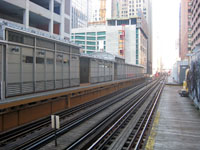
The new relay house and equipment facility for Tower 18, including an auxiliary control room, is seen looking north along Wells Street on November 21. 2009. For a larger view,
click here. (Photo by Graham Garfield) |
Divane Brothers Electric Company was selected following a competitive bid process. Funding for the project came from the Federal Transit Administration (FTA), the Regional Transportation Authority (RTA) and CTA bonds.
Work was expected to begin early in 2007 and be completed in 2009.5 However, problems with the contractor's performance6 7 8 and the broadening of the project scope to include track renewal on the Lake and Wabash sides of the Loop delayed the project, which was not substantially completed until July 2011.9 In addition, the total contract value increased to $67.9 million, with a total project budget of $103.2 million.
The Loop Signal Project included a new bidirectional cab signal system for the Loop Elevated, a new Tower 18 at Lake and Wells, a new interlocking at Jefferson on the Lake branch, a signal facility building for Tower 18 where the old Randolph/Wells station platforms were, and a new Tower 12 relay house, plus new control panels for Tower 12 and Jefferson Crossover. A portion of the bridge control system that operates the Lake and Wells Street bridges was also upgraded.
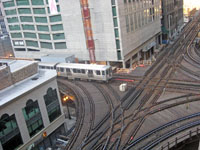
Junction 18 is seen looking northwest from above on November 21, 2009, as a Cottage Grove-bound Green Line train passes through. It's an average scene at this location except for one thing: there's no Tower 18! The old tower building has been removed in advance of the new one's installation, and the interlocking is being controlled from the auxiliary control room immediately to the south. For a larger view,
click here. (Photo by Graham Garfield) |
A new platform was constructed in 2008 at the former location of the remnants of the north end of the Randolph/Wells Outer Loop platform, stretching between Lake and Randolph on the west side of the tracks. The new structure was constructed to support a new relay house and ancillary control facility for Tower 18, both for the used during the construction of the new tower and after the new permanent interlocking was in place. The prefabricated buildings -- long, one-story arched-roof metal enclosures -- were lifted into place on January 25, 2009. The new equipment was wired in and brought online over the next 10 months.
Control of the Tower 18 interlocking was switched over from the old tower to the new relay house on November 16, 2009. Over the weekend of November 14-15, while the changeover was taking place, the switches in the interlocking were clamped into one position and trains were rerouted, with Orange and Brown line trains through-routed via the Lake and Wabash legs, while the Green and Pink lines were routed via the Wells and Van Buren sides; Pink Line trains terminated at Roosevelt. The new relay house was built with a temporary tower room and control panel, with monitors to watch the various approaches via cameras mounted on tall poles around the interlocking plant.
After the old tower was removed from service, the 1969-vintage building was demolished within one week. By Monday morning, November 23, a new pre-fabricated tower building had been lifted into place, in the same location in the northwest corner of the interlocking outboard of the tracks that the previous tower had been. During late 2009 and early 2010, work continued on wiring the new Tower 18 into the interlocking and replacing switches and relays at Tower 12.
On Sunday morning, May 16, 2010, the towerman moved from the relay house into the new tower and began to control the interlocking from the new facility while testing of the new tower panel and training of the tower personnel was completed. The new Tower 18 control facility was officially placed in service at 5am, Wednesday, May 19, 2010.
Tower 18's remote control of Jefferson Interlocking, immediately west of Clinton station on the Lake branch of the Green and Pink lines, a 1/2-mile west of Tower 18, was activated on Wednesday afternoon, December 12, 2012. Jefferson Interlocking is commonly used to turn back inbound trains when the Lake Street Bridge is up or during other service disruptions.
Tower 18 Track Renewal and Wells Street Bridge Rehabilitation
On July 15, 2011, the Chicago Transit Board approved a $33.8 million contract to begin work on the second half of the Loop Track Renewal project, which involved the replacement of deteriorated track and rail ties along the Wells and Van Buren elevated tracks. Portions of the Loop Elevated system that underwent renewal work in this next phase of work included the Tower 18 and Tower 12 junctions. The project also included replacement of other rail system components including foot walks, traction power and signal cabling, signal panels, switch machines, and rail lubricators.
Ragnar Benson Construction, LLC was awarded the contract through a competitive bid process. Funding for the Loop Track Renewal project was provided by a state grant through the RTA. Work began in late 2011 and was planned to be completed in late 2012, but the work at Tower 18 and on the Brown Line at Hubbard Curve just north of the Loop was deferred to piggyback on another project.
The Chicago Department of Transportation (CDOT) performed a ear-long reconstruction of the historic Wells Street Bridge in 2012-13, during which the CTA took the opportunity to perform track renewal at Tower 18 and on the Brown Line from the Loop and through Hubbard Curve north of Merchandise Mart station.
The bridge's historic elements, railings, bridge houses and major structural components will be replaced to preserve the 1920s look of the bridge. Crews will replace the trusses and all of the steel framing for the lower level road and upper level railway structures. The mechanical and electrical components will also be replaced. The bridge contractor, Walsh/II in One (JV), began work on November 5, 2012, and was expected to be complete by the end of November 2013. Southbound vehicular and pedestrian traffic on Wells was rerouted, including the CTA buses.
While the roadway was closed for the duration of the project, the construction work was designed to keep CTA rail service interruptions at a minimum. "L" trains continued to use the bridge during the project, except for two nine-day service interruptions in Spring 2013, when the CTA rebuilt the Tower 18 Loop 'L' junction at Lake and Wells streets. That work required two nine-day closures of the Wells bridge to Brown and Purple line trains, one in early March 2013, the other in late April.
The Tower 18 work was originally scheduled to be part of the Loop Track Renewal project, which was undertaken between April and November 2012. But by performing the work while CDOT completes the Wells Street Bridge repairs, CTA reduced the duration of the work by eight days. Additionally, combining the work saved CDOT and CTA $500,000 in construction coordination cost.
During the two nine-day closures, which ran from early morning Saturday through early Monday of the following week, alternative bus and rail service was provided. On weekdays, Brown Line trains alternated between terminating at Merchandise Mart station or continuing into Downtown through the State Street Subway. Bus shuttles were available from the Mart as well as special shuttle service on the Loop Elevated.
|
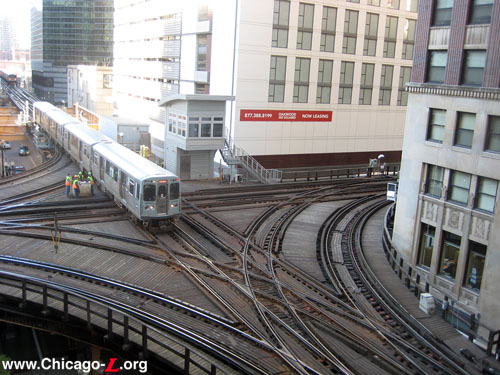
A four-car Pink Line train of 2600-series cars passes through the Tower 18 interlocking on its way into the Loop in this view looking west on November 30, 2011. A group of CTA signal maintainers is on the tracks next to the train. The interlocking tower was relatively new, brought into service only about a year and a half before. For a larger view, click
here.
(Photo by Graham
Garfield)
|

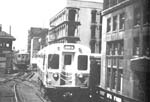
|
tower18b.jpg
(42k)
The original turn of the century-vintage Tower 18 has
survived into a new era, as it watches over a demonstration
run of the modern PCC 6000-series
cars on August 16, 1950. Although the rear car bears a Logan
Square route sign, it is actually turning north from the
Outer Loop onto the Ravenswood Line as a Lake Street train
of wooden cars leaves the junction heading west to Forest
Park. The 6000s
wear a paint scheme variation that were only used for a
short time on the first four cars, 6001-6004.
(Photo from the Krambles-Peterson
Archive)
|

|
tower18c.jpg
(42k)
Two Lake-Dan Ryan trains -- both 2-car trains of 2000-series
cars in the Bicentennial paint scheme -- pass each other at
the post-1969 Tower 18 during the midday service lull. The
near train is a "B" train heading into the Loop on its way
to 95th Street; the
far train is on its way back to Oak Park and Harlem
Terminal. (Photo from the Chicago
Transit Authority Collection)
|
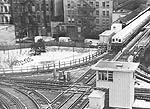
|
tower18d.jpg
(100k)
A view of Tower 18, looking south in the early 1980s. A
four-car Evanston Express train, led by the two 1-50s
and trailed by a 6000-series
pair, is about the enter the junction as it pulls away from
the Randolph/Wells
station in the upper right corner. Although the Randolph
station would remain open for another decade, the north end
is already being used for storage and to house equipment
sheds. (Photo from the Chicago Transit
Authority Collection)
|
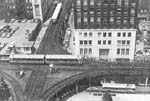
|
tower18f.jpg
(68k)
Bicentennial unit 1776 -- the Ben Franklin -- passes through
Tower 18 on August 1, 1975 on its way to Harlem
Terminal on the Lake-Dan Ryan. Meanwhile, a 2-car PCC
train, probably a Ravenswood, waits on Wells for the
Lake-Dan Ryan to clear the interlocking.
(Photo from the Chicago Transit Authority
Collection)
|

|
tower18h.jpg
(58k)
The More Things Change, The More They Stay the Same:
The tower, routings, and track configuration have changed in
the two decades since the photo above but the equipment is
the same, as three two-car Bicentennial 6000-series
trains pass through Tower 18 simultaneously on August 1,
1975 in the only way to do so: cars 6033-6034 "Thomas
McKean" (left) head straight through on the Ravenswood
All-Stop run into Randolph/Wells
(visible in the lower left corner); cars 6031-6032 "John
Parker" (front right) turn east on the Inner Loop on the
Loop Shuttle; and cars 6017-6018 "Haym Salomon" (back right)
turn north onto the Ravenswood on their way to Kimball
after completing a circuit on the Loop.
(Photo from the Chicago Transit Authority
Collection)
|
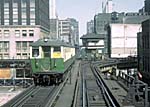
|
cta4000s08
(92k)
After completing its circuit around the Loop and passing
through Tower 18, a two-car train
of 4000-series
Plushie cars heads westbound on a Lake Street "A" run toward
Harlem in April 1964. Note that Tower
18 is in the middle of the junction and the track on the
right -- the eastbound Lake Street track, dead ends after
the switch to the Outer Loop. Five years later, this track
would be extended through to allow through-service over Lake
Street onto the Inner Loop for Lake-Dan Ryan service.
(Photo by Jerry Appleman)
|

|
tower18east.jpg
(48k)
Looking east out of the old Tower 18 towards the Clark
& Lake station in the 1960s. (Photo
by Peter Christy)
|

|
tower18south.jpg
(110k)
Looking south out of the old Tower 18 towards the Randolph
& Wells station in the 1960s. (Photo
by Peter Christy)
|

|
tower18west.jpg
(130k)
Looking west out of the old Tower 18 out the Lake Street
Line in the 1960s. The trestle bridge over the Chicago &
North Western can be seen in the distance.
(Photo by Peter Christy)
|

|
tower18int1.jpg
(108k)
An interior view of the old Tower 18 in the 1960s, showing
the interlocking controls, desks, and other facility
accouterments. The control panel suspended from the ceiling on the right controlled the Lake and Wells bridges. (Photo by Peter
Christy) |
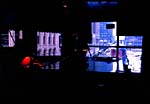
|
tower18NSL.jpg
(58k)
A low-lit view inside Tower 18, looking north out a set of
windows towards the Chicago River as a train of North Shore
Line Silverliners pass on their way north to Milwaukee or
Mundelein. (Photo by Peter
Christy)
|
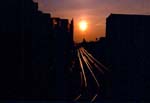
|
tower18gold.jpg
(26k)
Looking west out the Lake Street Line from Tower 18 as the
setting sun creates a beautiful golden
sunset. (Photo by Peter Christy)
|
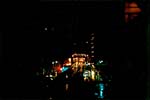
|
tower18east-AtNight.jpg
(67k)
This view looks out the front door window late one rainy
night in 1962. You can see a Ravenswood ready to depart the
Clark &
Lake station. The towerman, before taking this photo,
has already set the "inner-to-outer Loop" crossovers and
dropped the signal for him. From the back of the targets, we
see blue and white lenses, rather than red and green
aspects. Notice that both targets are showing red-over-green
(or blue-over-white, from this side). The Loop was
considered the "Main", or normal, routing. So if a train was
being routed off the Loop, the switches were aligned to
"Reverse" routing, and the signals (aka "targets") showed a
red-over-green aspect. The target positioned closer to the
tower is for the Lake Street Line. Technically, it should
probably be set for red-over-red, but the towermen at the
time usually didn't do that if they knew a Lake train was
following the Ravenswood, and was due off the Loop before
the next Ravenswood was due on. (Photo by
and information from Peter Christy)
|
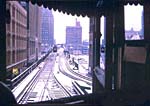
|
tower18north-WinterDay.jpg
(114k)
This view looking north from inside Tower 18 not only shows
an inbound North Shore Line train, its reflection framed in
the open window, but one can also see an inbound Lake Street
train, just crossing the bridge, reflected in the
"side-view" mirror. The strategically placed "side-view"
mirror allowed towermen to see what was going on behind them
to the west while looking north, and while looking east a
"rearview" mirror mounted on the wall, just to the right of
the door, allowed then to see what was going on behind to
the west. Typically, they didn't spend much time looking
south, since those trains were going away from them. But,
with just a little head movement to look from east to north
(and being able to see south at the same time), they could
keep track of the speeds and positions of the traffic
entering the Loop, and time their moves to facilitate the
flow. (Photo by and information from Peter
Christy)
|
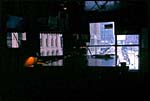
|
tower18north-WinterDay2.jpg
(81k)
This 1962 view is similar to another shot above, showing an
outbound North Shore Line Silverliner. The towermen at Tower
18 would only need to worry about the North Shore Line's
trains for less than a year before the interurban ceased
operations. (Photo by Peter
Christy)
|
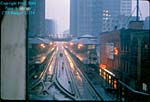
|
tower18south-RainyDay.jpg
(148k)
Looking to the south through the bay-window from the seat
behind the console in 1962, several details are visible
besides the Randolph
& Wells station in the background. The "Inner Loop
around" curve is still in place at this point and you can
see the pneumatic switch cylinder at trackside just to the
left of the points. The two nearby targets (you can see the
light shining through their blue lenses) are "backup"
signals. These were only used to direct trains back against
the normal flow of traffic when some unusual circumstance
required it. On the west (right) side of the Randolph
& Wells station platform, you can see a light inside
the bay window of the station house that intrudes onto the
platform. This was the Randolph
& Wells Supervisor's Office. It was pretty easy to
see when the Supervisor was in because he'd be silhouetted
right in the center of the window. Further down the line,
between the tracks, you can see the green aspect glow of a
signal. This was the target for the Lake Street trains,
protecting the Outer-to-Inner Ravenswood
crossover. (Photo by and information from
Peter Christy)
|

|
tower18-IntrlckngMach.jpg
(62k)
This 1962 view of Tower 18's interlocking machine shows the
interlocking levers (Red = Signal, Red-Yellow = Signal &
Trip, Black = Switch) used for the "outlying" switches (e.g.
the outer-to-inner, and inner-to-outer Loop switches to
route Ravenswood trains during non-rush
hour). (Photo by and information from Peter
Christy)
|

|
tower18-BridgeMach.jpg
(100k)
This view from 1962 shows the Union Switch & Signal Company machine
used to "give power" to the two City of Chicago bridge
tenders. The CTA didn't want to allow the City employees to have full control
of the bridges over the Chicago River used for
CTA traffic. If one
of the bridge tenders saw that he was going to have to raise
his bridge, he'd ring up Tower 18 (using a hand crank
telephone) to advise the towerman, who'd go through a
sequence that would set signals to red, raise the track
trips, set the switches to route into bumping blocks, and
finally close circuits that feed power into the massive
steel bars that hold the two sides of the bridge locked
together, while also closing circuits that feed power to the
Bridge Tender's controls. Then, and only then, was the city
bridge Tender able to operate his controls to lift the
bridge. The box on the Interlocking console, next to the
telephone, was the "squawk-box." By flipping the appropriate
switch. the towermen were in instant contact with the
Supervisor's Office at Randolph
& Wells or Clark
& Lake, or with the Power Supervisor at the
Merchandise Mart. The microphone sat on the console to the
right of the telephone. The loud speaker was mounted
overhead. This arrangement could be a little unnerving when
one would suddenly hear a booming "voice from above" when
one of these gentlemen wanted to contact
you. (Photo by and information from Peter
Christy)
|

|
tower18i.jpg
(237k)
Looking west at Tower 18 from the Clark/Lake
outer platform in March 2002 as an East 63rd branch Green
Line train passes through the interlocking into the Loop.
(Photo by Robert Mencher)
|
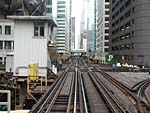
|
tower18k.jpg
(211k)
This view shows how Tower 18 looks contemporarily looking
east from the Lake Street approach to the Loop. Barely
visible on the right is the Lake-to-Outer Loop curve, which
is not used in regular operations, but is brought into
service when Lake trains need to be short-turned on the Loop
and during certain other unusual moves. The external
stairway from track-level to the second floor of the tower,
where the interlocking panel and other control equipment is
located, is evident. Clark/Lake
station is visible in the background. (Photo
by Graham Garfield)
|
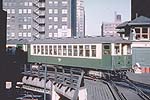
|
cta4407b.jpg
(134k)
Until the Lake Line was through-routed with the Dan Ryan
Line in 1969, it terminated around the Loop. Starting in
1913, it operated counterclockwise on the Inner Loop. Here,
car 4407 leads a Lake "B" train through the Tower 18
interlocking, across the Outer Loop track (by this point
used primarily by Ravenswood trains) toward Randolph/Wells
in January 1964. (Collection of Joe
Testagrose)
|

|
cta4446.jpg
(162k)
After completing a circuit around the Inner Loop, an
Evanston Express train led by car 4446 heads north through
Tower 18 at Lake & Wells after stopping at Randolph/Wells
(seen in the background) on October 3, 1972.
(Photo by Steve Zabel, Collection of Joe
Testagrose)
|
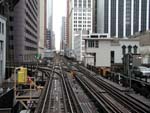 |
tower18j.jpg (??k)
This April 4, 2002 view shows Tower 18 as seen from the Wells Street approach to the Loop, looking south. (Photo
by Graham Garfield) |
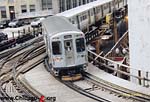
|
cta3208.jpg
(150k)
A Brown Line train trailed by 3200-series
car 3208 leaves the Loop to head north toward Kimball,
crossing through Tower 18, on May 8, 2002.
(Photo by Ernie Baudler)
|
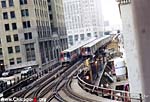
|
cta2400s@tower18a.jpg
(124k)
Two Purple Line trains -- the one on the right heading
northbound to Evanston, the one on the left southbound into
the Loop -- pass each other just north of Tower
18 at Lake and Wells on May 8, 2002.
(Photo by Ernie Baudler)
|

|
cta2400s@tower18b.jpg
(129k)
An eastbound Green Line train of 2400-series
cars waits for a northbound Purple Line express train bound
for Evanston to cross the junction of Tower
18 on May 8, 2002. (Photo by Ernie
Baudler)
|

|
cta2400s@tower18c.jpg
(158k)
An eastbound Green Line train bound for the East 63rd branch
approaches the "tic-tac-toe" crosshatch of tracks that makes
up one the busiest railroad intersections in the country,
Tower 18, on May 8,
2002. (Photo by Ernie Baudler)
|
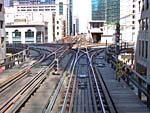
|
tower18l.jpg
(218k)
Tower 18 and the junction it controls is seen looking west
on Lake Street on June 19, 2006. The X10 home signal
governing the westbound track and the position of the
switchpoints the signal governs show that the the tour has a
route in for the Brown Line, turning from west on Lake to
north on Wells. (Photo by William
Davidson)
|
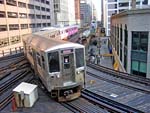
|
cta2208.jpg
(225k)
Car 2208 leads a 4-car rush hour Pink Line train, making the
turn at Tower 18 from the Inner
Loop onto the Lake
branch for the trip back to 54/Cermak
on June 30, 2006, five days after the route began service.
The last four cars -- 3007-08 -- are wrapped in pink and
were one of three 2-car units used for the ceremonial
inaugural train for the Pink Line on June 24, 2006. The
2200s' use on
the Pink Line marks the cars' first regular use in scheduled
service on the Loop since the cars were reassigned off the
West-South Route in 1983. (Photo by Graham
Garfield)
|
 |
tower18m.jpg (183k)
A crane has finished lifting and lowering the new prefabricated relay house and auxiliary equipment facility for Tower 18 into place on its platform south of the junction, seen looking north from Washington/Wells on the evening of January 25, 2009. Train traffic between Washington/Wells and Tower 18 was suspended for the day to allow the work to take place. (Photo by Graham
Garfield) |
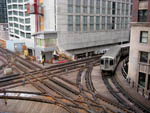 |
tower18p.jpg (250k)
A Brown Line train is rounding the curve at Tower 18 on its way back north to Kimball in this scene looking northwest on January 26, 2010. The new tower's structure is in place, but the building is still being built out, as evidenced by the sections of exterior panelling yet to be installed and the lack of windows at the control room level. (Photo by Graham
Garfield) |
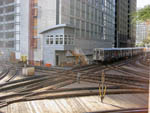 |
tower18q.jpg (215k)
The new Tower 18 is nearly ready for use as a Brown Line train approaches on its way into the Loop, looking northwest on May 1, 2010. The building is so new, the manufacturer's decals are still on the window glass. Although some work was still yet to be done, the new tower would be controlling the interlocking again about two weeks later. (Photo by Graham
Garfield) |

|
cta5695-96_5304-03-Cubs.jpg (235k)
All four Cubs World Series cars -- in order from the front (left), 5695-5996-5304-5303 -- wrap around the Inner Loop-to-westbound Lake Street curve normally used by Pink Line trains at Tower 18 on April 23, 2017, while running on a private charter. (Photo by David Harrison) |


- tower18-1897.jpg
(30k): The configuration of Junction 18 as it was between 1897 and
1900. The westbound Fifth & Lake station remains and there is
no tower as of yet. (Graphic by Graham Garfield)
.
- tower18-1902.jpg
(32k): Junction 18, as it was configured following the opening of
the Northwestern Elevated in 1900. It remain largely the same
until the 1913 through-routing revisions.
(Graphic by Graham Garfield)
.
- tower18-1912.jpg
(32k): The configuration at Tower 18, just before the 1913
reconfiguration. Little had changed since 1902, except that the
diamond crossover at Lake & Franklin, west of the junction,
had been replaced with two separate right- and left-hand switches.
(Graphic by Graham Garfield)
.
- tower18-1930.jpg
(36k): The junction as it appeared between the 1913 and
1969 service revisions. (Graphic by Graham
Garfield)
.
- tower18-1975.jpg
(36k): Tower 18, as it was configured following the 1969
inauguration of Lake-Dan Ryan service. The tower has been moved
from within the junction to the northwest corner and the tracks
have been completely reconfigured. The junction is largely the
same today. (Graphic by
Graham Garfield)
.
- tower18-1994.jpg
(36k): Although largely unaltered since 1969, the two separate
right- and left-hand switches east of the junction on Lake have
been replaced with a diamond crossover.
(Graphic by Graham Garfield)
.
- tower18-1999.jpg
(38k): The Tower 18 interlocking now includes an
"Outer-Loop-around" routing. The adjacent Randolph/Wells
station has been closed, but the platforms remain for storage.
(Graphic by Graham Garfield)

|

|
Notes:
- Moffat, Bruce, The "L": The Development of Chicago's Rapid Transit System, 1888-1932 (Bulletin 131). Chicago: Central Electric Railfans' Association, 1995, 177.
- "'L' Loop Crossing Is World's Busiest", Go on the "L" newsletter, Vol. 1 No. 1, February 15, 1936, pg. 2
- Correspondence with Kendrick Bisset, former CTA Director, Power and Way Engineering, 2011 April 29-30.
- Ibid, 2012 January 29-February 5.
- "Construction Project Briefing." Report to the Chicago Transit Board. 2011 July 15, pg. 7.
- "Problems in Loop could further delay CTA project." Chicago Tribune. 2008 September 11.
- "Loop L signal work delayed." Chicago Sun-Times. 2008 September 11.
- "CTA work may be delayed by year." WLS-TV Chicago online. 2008 September 11.
- "Construction Project Briefing." Ibid.











































